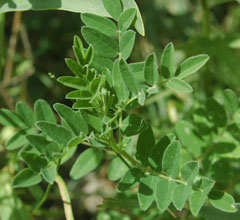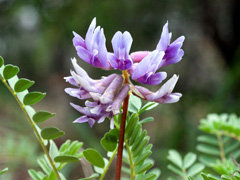 |
|
http://commons.wikimedia.org/wiki/User:Doronenko |
 |
|
Translate this page:
Summary
Physical Characteristics

 Astragalus membranaceus is a PERENNIAL growing to 0.3 m (1ft) by 0.3 m (1ft in) at a medium rate.
Astragalus membranaceus is a PERENNIAL growing to 0.3 m (1ft) by 0.3 m (1ft in) at a medium rate.
See above for USDA hardiness. It is hardy to UK zone 6. It is in flower from June to August, and the seeds ripen from July to September. The species is hermaphrodite (has both male and female organs) and is pollinated by Bees, Lepidoptera (Moths & Butterflies). The plant is self-fertile.
It can fix Nitrogen.
Suitable for: light (sandy) and medium (loamy) soils and prefers well-drained soil. Suitable pH: neutral and basic (mildly alkaline) soils. It cannot grow in the shade. It prefers dry soil.
UK Hardiness Map
US Hardiness Map
Synonyms
Astragalus propinquus
Plant Habitats
Cultivated Beds;
Edible Uses
1. Nectary - Flowers rich in nectar and pollen:
Yes –Astragalus species produce flowers that are rich in nectar, making them attractive to pollinators such as bees and butterflies.
2. Wildlife - Food (Fruit, Seeds, Leaf litter, Shelter, Nesting, Roosting):
Yes – The seeds of Astragalus species are edible and can serve as food for various wildlife. The plant’s foliage may also provide cover for small animals, although it is not typically used for nesting.
3. Invertebrate Shelter (Overwintering sites, Leaf litter, Groundcover):
Yes – Astragalus species can provide habitat for invertebrates, and its leaves contribute to leaf litter that supports beneficial insects. Some species may spread out enough to offer ground cover.
4. Pest Confuser (Smell):
No – Astragalus species are not specifically recognized for its ability to confuse pests through its scent.
References More on Edible Uses
Medicinal Uses
Plants For A Future can not take any responsibility for any adverse effects from the use of plants. Always seek advice from a professional before using a plant medicinally.
Adaptogen Antibacterial Cancer Cardiotonic Diuretic Febrifuge Hypoglycaemic Hypotensive
Pectoral Tonic Uterine tonic Vasodilator
Huang Qi is commonly used in Chinese herbalism, where it is considered to be one of the 50 fundamental herbs[218]. The root is a sweet tonic herb that stimulates the immune system and many organs of the body, whilst lowering blood pressure and blood sugar levels[238]. It is particularly suited to young, physically active people, increasing stamina and endurance and improving resistance to the cold - indeed for younger people it is perhaps superior to ginseng in this respect[254]. Huang Qi is used especially for treatment of the kidneys and also to avoid senility[218]. The plant is often used in conjunction with other herbs such as Atractylodes macrocephala and Ledebouriella seseloides[238]. The root contains a number of bio-active constituents including saponins and isoflavonoids[279]. It is adaptogen, antipyretic, diuretic, tonic, uterine stimulant and vasodilator[218, 254, 279]. It is used in the treatment of cancer, prolapse of the uterus or anus, abscesses and chronic ulcers, chronic nephritis with oedema and proteinuria[176, 218]. Recent research in the West has shown that the root can increase the production of interferon and macrophages and thus help restore normal immune function in cancer patients[254, 279]. Patients undergoing chemotherapy or radiotherapy recover faster and live longer if given Huang Qi concurrently[254]. The root of 4 year old plants is harvested in the autumn and dried for later use[238, 254]. The plant is antipyretic, diuretic, pectoral and tonic[218]. Extracts of the plant are bactericidal, hypoglycaemic and hypotensive[218]. Cardiotonic, vasodilator[176].HIV Infections [301].
References More on Medicinal Uses
The Bookshop: Edible Plant Books
Our Latest books on Perennial Plants For Food Forests and Permaculture Gardens in paperback or digital formats.

Edible Tropical Plants
Food Forest Plants for Hotter Conditions: 250+ Plants For Tropical Food Forests & Permaculture Gardens.
More

Edible Temperate Plants
Plants for Your Food Forest: 500 Plants for Temperate Food Forests & Permaculture Gardens.
More

More Books
PFAF have eight books available in paperback and digital formats. Browse the shop for more information.
Shop Now
Other Uses
Are there any agroforestry uses?
Astragalus species are often used as a cover crop and for erosion control. It improves soil fertility through nitrogen fixation and can be used in mixed plantings to enhance biodiversity. Nitrogen Fixer. Provides shelter for beneficial invertebrates: insects and other arthropods. A general nectary plant [1-2]. 1. Nectary - Flowers rich in nectar and pollen:
Yes –Astragalus species produce flowers that are rich in nectar, making them attractive to pollinators such as bees and butterflies.
2. Wildlife - Food (Fruit, Seeds, Leaf litter, Shelter, Nesting, Roosting):
Yes – The seeds of Astragalus species are edible and can serve as food for various wildlife. The plant’s foliage may also provide cover for small animals, although it is not typically used for nesting.
3. Invertebrate Shelter (Overwintering sites, Leaf litter, Groundcover):
Yes – Astragalus species can provide habitat for invertebrates, and its leaves contribute to leaf litter that supports beneficial insects. Some species may spread out enough to offer ground cover.
4. Pest Confuser (Smell):
No – Astragalus species are not specifically recognized for its ability to confuse pests through its scent.
Special Uses
Food Forest Nitrogen Fixer
References More on Other Uses
Cultivation details
Requires a dry well-drained soil in a sunny position[1]. Prefers a sandy slightly alkaline soil[238]. Plants are hardy to at least -15°c[238]. There is some disagreement over the correct name for this species, with several authorities seeing it as part of A. penduliflorus[261]. The Flora of China treats it as a sub-species of A. mongholicus, as A. mongholicus dahurica[266]. Plants are intolerant of root disturbance and are best planted in their final positions whilst still small[200]. This species has a symbiotic relationship with certain soil bacteria, these bacteria form nodules on the roots and fix atmospheric nitrogen. Some of this nitrogen is utilized by the growing plant but some can also be used by other plants growing nearby[200]. Many members of this genus can be difficult to grow, this may be due partly to a lack of their specific bacterial associations in the soil[200]. For polyculture design as well as the above-ground architecture (form - tree, shrub etc. and size shown above) information on the habit and root pattern is also useful and given here if available. The plant growth habit is a clumper with limited spread [1-2].
References Carbon Farming Information and Carbon Sequestration Information
Temperature Converter
Type a value in the Celsius field to convert the value to Fahrenheit:
Fahrenheit:
The PFAF Bookshop
Plants For A Future have a number of books available in paperback and digital form. Book titles include Edible Plants, Edible Perennials, Edible Trees,Edible Shrubs, Woodland Gardening, and Temperate Food Forest Plants. Our new book is Food Forest Plants For Hotter Conditions (Tropical and Sub-Tropical).
Shop Now
Plant Propagation
Seed - best sown as soon as it is ripe in a cold frame[200]. A period of cold stratification may help stored seed to germinate[200]. Stored seed, and perhaps also fresh seed, should be pre-soaked for 24 hours in hot water before sowing - but make sure that you do not cook the seed[134, 200]. Any seed that does not swell should be carefully pricked with a needle, taking care not to damage the embryo, and re-soaked for a further 24 hours[134, 200]. Germination can be slow and erratic but is usually within 4 - 9 weeks or more at 13°c if the seed is treated or sown fresh[134]. As soon as it is large enough to handle, prick the seedlings out into individual pots and grow them on in the greenhouse for their first winter, planting them out into their permanent positions in late spring or early summer, after the last expected frosts.
Other Names
If available other names are mentioned here
Native Range
TEMPERATE ASIA: Amur, Buryatia, China, Chita, Gansu Sheng, Gorno-Altay, Habarovskij kraj, Hakasija, Hebei Sheng, Heilongjiang Sheng, Irkutsk, Jilin Sheng, Kazakhstan, Krasnoyarsk, Liaoning Sheng, Mongolia, Nei Mongol Zizhiqu, Novosibirsk, Primorye, Qinghai Sheng, Respublika, Respublika, Russian Federation, Shaanxi Sheng, Shandong Sheng, Shanxi Sheng, Sichuan Sheng, Tomsk, Tyva, Xinjiang Uygur Zizhiqu, Xizang Zizhiqu, Yakutia-Sakha,Russian Federation.
Weed Potential
Right plant wrong place. We are currently updating this section.
Please note that a plant may be invasive in one area but may not in your area so it's worth checking.
Conservation Status
IUCN Red List of Threatened Plants Status :

Growth: S = slow M = medium F = fast. Soil: L = light (sandy) M = medium H = heavy (clay). pH: A = acid N = neutral B = basic (alkaline). Shade: F = full shade S = semi-shade N = no shade. Moisture: D = dry M = Moist We = wet Wa = water.
Now available:
Food Forest Plants for Mediterranean Conditions
350+ Perennial Plants For Mediterranean and Drier Food Forests and Permaculture Gardens.
[Paperback and eBook]
This is the third in Plants For A Future's series of plant guides for food forests tailored to
specific climate zones. Following volumes on temperate and tropical ecosystems, this book focuses
on species suited to Mediterranean conditions—regions with hot, dry summers and cool, wet winters,
often facing the added challenge of climate change.
Read More
Expert comment
Author
Moench.
Botanical References
238266
Links / References
For a list of references used on this page please go here
Readers comment